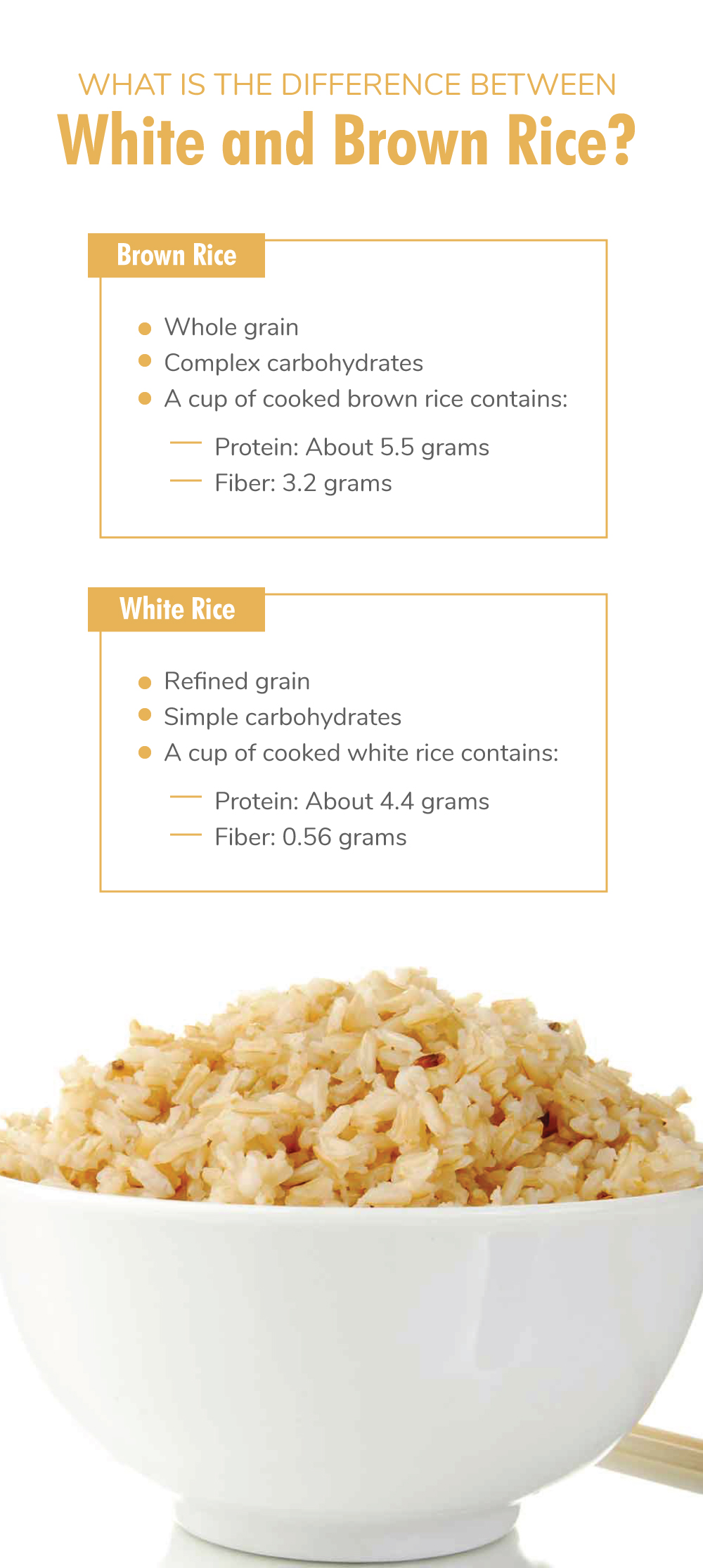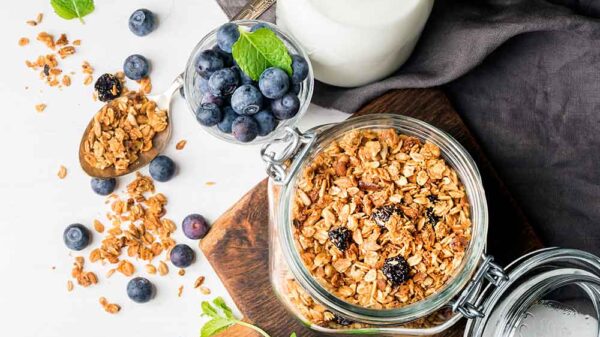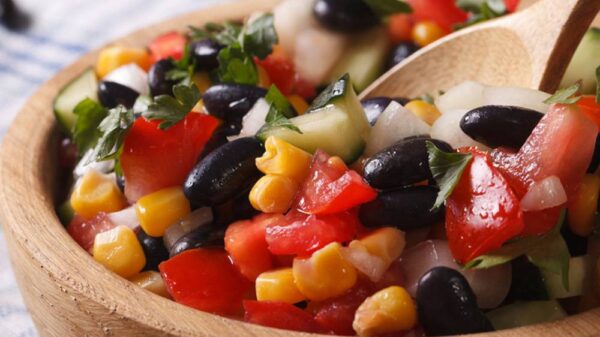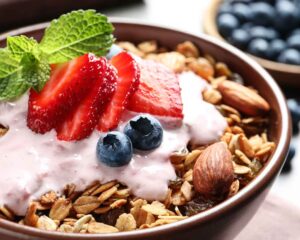Rice is a primary food source for many populations across the globe and is a staple food in many cuisines. When we think of rice, we may think of Asian dishes served with sticky rice, sushi rolls, or a Mexican dish with rice in beans. Rice is diverse in size and color; it can be long-grain or short-grain and may be red, black, purple, brown, or white. Two of the most popular kinds of rice are white and brown rice. But what is the difference between white and brown rice, and which one is better for you? Keep reading to have these questions answered!
What’s in a Grain of Brown Rice?
Rice has been a major food source for thousands of years, especially in Asia. Rice is an adaptable grain that can grow in a variety of environments, as long as sufficient water can be provided.
Brown rice is a whole grain, and one of the least processed kinds of rice. Commonly, we use the term “brown rice” to refer to whole grain rice in general. However, there are several types of whole grain rice
Each grain of rice contains a husk, a layer of bran, a starchy interior, and the germ. The husk and bran form a capsule around each grain and contain the highest concentration of nutrients. The husk is the outermost layer of a rice grain and has a tough, chewy texture. To make rice edible, this husk must be removed.
After the husk is removed, the rest of the rice grain is left intact; this final product is called brown rice.
White Rice Is Made from Brown Rice
The presence of the bran layer distinguishes brown rice from white rice. To create white rice, brown rice is further processed through milling, the bran layer is removed from the brown rice, leaving the starchy interior called the endosperm. This resulting product is a refined grain, which we call white rice. (1)
Is Rice Good for You? Brown Rice vs White Rice
In a nutshell, brown rice has a higher nutritional value than white rice. When it comes to carbohydrates, less processing equates to more nutrients. For a helpful comparison, think about the range of breads available at the grocery store. Highly processed breads tend to be softer, whiter in color, and lower in nutrient content. Less processed breads tend to be denser, darker in color, and rich in nutrients. The same concept applies to white and brown rice.
Let’s take a look at the ways brown rice is nutritionally superior to white rice.
Brown Rice Has More (and Higher-Quality) Protein
Based purely on protein quantity, brown rice is a better source of protein than white rice. A cup of cooked brown rice contains about 5.5 grams of protein, while a cup of cooked white rice contains about 4.4 grams of protein. (2,3)
More importantly, brown rice has a higher and more complete amino acid content than white rice. This is because white rice is milled and processed to remove the husk and nutrient-dense bran layers.
Protein is comprised of amino acids, and there are nine essential amino acids that we must get from the food we eat. These amino acids are isoleucine, leucine, histidine, lysine, methionine, phenylalanine, threonine, tryptophan, and valine. We need sufficient amounts of all of these amino acids in order to support optimal biological functioning and physical health. Protein quality can be evaluated using the protein digestibility corrected amino acid score (PDCAAS). The PDCAAS for an ideal protein source will be 1 and contain adequate and digestible amounts of all essential amino acids. A less ideal protein sources have a PDCAAS less than 1.
Comparing the amino acid profiles, we see that both white and brown rice contain all essential amino acids. However, brown rice contains higher amounts of essential amino acids than white rice does and therefore has a higher PDCAAS. In comparison to white rice, brown rice contains approximately twice the amount of all essential amino acids. (4)
Brown Rice is Higher in Fiber
Fiber is a critical nutrient that is abundant in fruits, vegetables, and whole grains. When brown rice is milled to become white rice, the fiber-rich part is removed. For comparison, a cup of cooked brown rice contains about 3.2 grams of fiber, while a cup of cooked white rice contains only 0.56 grams of fiber. (5,6) Fiber supports digestive health, aids weight loss, and is also associated with a lower risk of both cardiovascular disease and metabolic syndrome.
Brown Rice Contains More B Vitamins Than White Rice
Unless white rice is fortified with B vitamins, the majority are removed through the milling process. Though white rice in the United States is fortified with B1 and B3, obtaining naturally occurring vitamins and nutrients is preferable. Your body is able to more effectively access and utilize micronutrients that are naturally occurring in foods, instead of artificially added. (7)
Brown rice is naturally higher in vitamin B1 (thiamin), vitamin B2 (riboflavin), vitamin B3 (niacin), and vitamin B6 (pyridoxine). B vitamins are critical to our metabolism and often function as raw materials used in the synthesis of biologically useful compounds. Other B vitamins work as cofactors that allow enzymes to do their job. Without B vitamins, our body wouldn’t be able to function! Our cells rely on B vitamins to manufacture DNA, build neurotransmitters, and harness energy from the foods we eat.
Brown Rice is Higher in Antioxidants Than White Rice
Research shows that the bran layer present in brown rice is rich in bioactive compounds that exhibit antioxidant activity, like phenolic acids, anthocyanins, and tocopherols. (8) As a waste product of cellular processes, free radicals accumulate and impede normal functioning. Over time, free radicals can damage tissues, inhibit organ function, and increase the risk of cancer. The antioxidants found in rice bran protect your body from damage on a molecular level by scavenging free radicals and essentially cleaning up cellular waste, allowing biological processes to occur smoothly.
Systemic inflammation also increases your risk for tissue damage and cancer growth. The components of rice bran are also potent anti-inflammatory agents, and support healthy organ functioning by calming immune system responses. Research has shown that rice bran fights against cancer by inducing apoptosis (the scientific term for death) of tumor cells and helping prevent metastasis. (9) Additionally, brown rice helps alter the gut microbiome, increase colonies of beneficial bacteria, and improve gut-mediated immune response.
Brown Rice Has More Minerals Than White Rice
In comparison to white rice, brown rice contains much more manganese and selenium. Selenium is a particularly important mineral that facilitates antioxidant activity in the body. By encouraging DNA repair and destroying malignant cells, selenium also protects against cancer and damage. Selenium also plays a particularly important role in activating glutathione peroxidase, an antioxidant enzyme that helps the liver break down and neutralize toxins. (7)
Carbohydrate Content of White vs. Brown Rice
Both white rice and brown rice are carbohydrate-rich grains, which are broken down into glucose that our cells can use as energy to fuel everything we do. For example, our brains require glucose to power complex electrical signaling, and our muscles require glucose to power movement. Even though we know that our bodies need carbohydrates for optimal functioning, a lot of questions have surrounded carbohydrates and whether they are good for you. The answer depends on the type of carbohydrate you are consuming.
Your body processes brown rice differently than white rice, leading to different biological outcomes for the body. White rice is categorized as a refined carbohydrate, which is also referred to as a simple carbohydrate. When you consume simple carbs, your body is able to rapidly break down carbohydrate molecules into glucose molecules, which in turn spikes your blood sugar. Foods that cause your blood sugar levels to skyrocket are described as having a high glycemic index.
In response to elevated blood sugar levels, your pancreas releases insulin so your cells remove sugar from the bloodstream and use it to power physiological processes. Consumption of excess simple carbohydrates like white rice taxes your body’s ability to remove sugar from the bloodstream, which increases your risk of developing insulin resistance, diabetes, and metabolic syndrome.
Since brown rice is a whole grain, it is categorized as a complex carbohydrate. The carbohydrates in brown rice are bundled together with health-promoting nutrients like fiber, vitamins, minerals, and antioxidants. As a result, your body slowly converts brown rice into useable energy, avoiding the undesirable blood sugar spikes that occur when you eat white rice. In contrast to simple carbs, complex carbs like brown rice have a low glycemic index.
A study published in the Diabetes Technology & Therapeutics journal shows the benefits of brown rice on blood sugar response. Researchers examined the diets of 15 overweight individuals and replaced white rice with brown rice. Results showed that individuals on the brown rice diet had a decreased glycemic response and significantly lower fasting insulin levels. (10)
Another study conducted by the Harvard School of Public Health evaluated the diets of 197228 men and women and found that substituting brown rice for white rice decreased the risk of developing type 2 diabetes. (11)
The Healthiest Rice: Germinated Brown Rice
Germinated brown rice, also known as sprouted brown rice, is the healthiest rice and has even more health benefits than regular brown rice. The germination process produces a seedling that has the potential to grow into a plant. To create germinated rice, brown rice is soaked in warm water until visible sprouts emerge from the grains. Interestingly, in comparison to regular brown rice, sprouted brown rice contains higher amounts of nearly all nutrients including protein, lysine, fiber, vitamins, minerals, and antioxidants. (12)
The particularly high levels of gamma-aminobutyric acid in sprouted brown rice have implications for protecting brain health and preventing neurodegenerative disease. Sprouted brown rice also contains acylated steryl glucoside, a compound that may help treat metabolic syndrome. (12)
Furthermore, the germination process chemically alters phytic acid, which is naturally occurring in brown rice. In regular brown rice, phytic acid is sometimes described as an anti-nutrient and may impede the natural absorption of nutrients in the digestive tract. However, because phytic acid becomes unreactive after germination, it is no longer able to impede nutrient absorption. (12)
Researchers suggest that through the germination process, the nutrients in brown rice become more bioavailable and easier for our cells to harness and use. Plus, as a bonus, sprouted brown rice is more texturally appealing and milder in flavor than brown rice. (12)
Precautions: Arsenic in Rice
Arsenic is present in nature, and in the organic form, is not harmful to humans when consumed in trace amounts. On the other hand, inorganic arsenic is toxic, causes cancer and heart disease, and has harmful health consequences for children. Rice tends to have a higher concentration of arsenic than other crops. Researchers at the Division of Bioanalytical Chemistry at the U.S. Food and Drug Administration found that cooking rice in high amounts of water successfully reduced the levels of inorganic arsenic. (13)
Conclusion
Rice is filled with health-benefitting nutrients like protein, fiber, antioxidants, and vitamins. The difference between brown and white rice comes down to nutrient content. Brown rice is a healthier choice than white rice, providing higher amounts of nearly all nutrients. The most nutrient-dense rice option is germinated brown rice. You can incorporate brown rice into your meal as a healthy, delicious, and versatile grain.

References:
1. https://www.ncbi.nlm.nih.gov/pmc/articles/PMC3138007/
2. https://fdc.nal.usda.gov/fdc-app.html#/food-details/169704/nutrients
3. https://fdc.nal.usda.gov/fdc-app.html#/food-details/168880/nutrients
4. https://tools.myfooddata.com/protein-calculator.php?foods=169704-168878&serv=wt1&qty=1-1
5. https://fdc.nal.usda.gov/fdc-app.html#/food-details/169704/nutrients
6. https://fdc.nal.usda.gov/fdc-app.html#/food-details/168880/nutrients
8. https://www.ncbi.nlm.nih.gov/pmc/articles/PMC3959956/
9. https://www.ncbi.nlm.nih.gov/pmc/articles/PMC3648746/
10. https://www.ncbi.nlm.nih.gov/pmc/articles/PMC3996977/
11. https://www.ncbi.nlm.nih.gov/pubmed/20548009/























